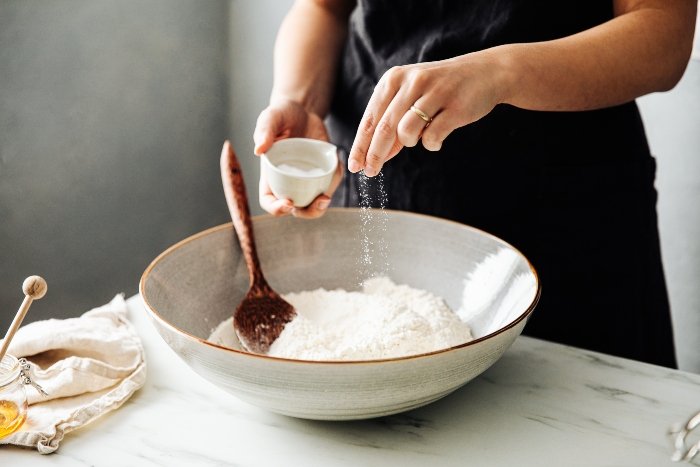
The saltiest foods are not the ones you think they are.
Most Americans consume far more sodium than the American Heart Associations (AHAs) recommended maximum of 2,300 mg per day.Even if you do not use the saltshaker, you probably take in too much sodium, which is linked to high blood pressure, stroke, heart disease, and even stomach cancer, kidney stones and weak bones.Where does excess sodium comes from?Mostly everything you eat has at least some sodium: Spinach, broccoli, and milk all have small amounts of naturally occurring sodium, but the big sodium offenders are not unprocessed or minimally processed foods like these.Nearly three-quarters of our sodium intake comes from packaged, prepared and restaurant foods.
Even more surprising is that your most salty-tasting foods might not really be so salty.And the ones with off-the-charts sodium content often do not taste salty at all.For example, 1-ounce of salted peanuts has only 115 mg of sodium, but -cup of instant chocolate pudding has about four times as much sodium.
The salt on the outside of peanuts, pretzels, popcorn, and French fries hits your taste receptors as soon as the food enters your mouth.You know right away your foods been salted.But when the salt is cooked within the food or if it is masked by spicy or sweet flavors, your tastebuds do not readily register a salty taste.
You can eat a days worth of sodium in a single meal without your food tasting especially salty.That is why I say you are probably getting more sodium than you think you are.The Salty Six Add Up TooEven foods with moderate amounts of sodium can increase your intake because you eat them frequently.
Take bread, for example.While brands vary in sodium level, an average slice of bread with only 150 mg of sodium adds up if you eat toast at breakfast, a sandwich at lunch and a dinner roll at your evening meal.The American Heart Association identified the Salty Six the six foods that contribute the most sodium in the U.S.diet.
You probably eat at least a couple of these regularly.If so, try to pick a lower-sodium brand or eat smaller portions.Bread and rolls Pizza Sandwiches Cold cuts and cured meats Soup Burritos and tacos8 Things You Can DoFew people reach the AHA limit of 2,300 mg daily (thats about 750 mg per meal, assuming no snacks), and far fewer meet the AHA ideal goal of only 1,500 mg daily (about 500 per meal).Admittedly, cutting sodium back to these levels is not easy, so the AHA advises you to cut back 1000 mg daily.
I will add that you should cut back any amount you can unless advised otherwise by your healthcare provider.These 8 steps will make a dent in your sodium overload.Kindly make requests When dining out, ask your server to recommend lower-sodium options.These words on a menu hint at high sodium:Pickled Barbequed Cured Soy sauce Smoked TeriyakiDrain and rinse canned beans and vegetables You wash away a whopping 40 percent of the sodium in canned garbanzos, green beans, and black beans this way.
Combine canned goods Use no salt added canned goods as much as possible.
But if they are too bland, use a combination of regular and unsalted products to cut your sodium intake by almost half.Try it next time you are cooking up spaghetti sauce.Grab a can of regular tomato sauce and a can of no salt added tomatoes.
I think you will be surprised.Use half of a seasoning pack You do not have to use all or even any of a salty spice packet that comes with convenience foods.You are not wasting a seasoning pack; you are saving your health.Season wisely Sprinkle fresh and dried herbs and spices liberally during cooking and after.Experiment with sodium-free spice blends like Mrs.
Dash.At the end of cooking, add lemon juice to soups and stews.The acid enhances the salt already in the food.Opt for a salt substitute You can pick one up in the grocery store to use in place of table salt.
But check in with your healthcare provider first, as some interfere with prescription drugs or can aggravate certain health problems.
Eat fresh foods when you can Yes, nearly everything has sodium, but your freshest foods will always be the lowest.
Read food labels You already know you cannot go on taste to identify a salty food.You cannot go on hunch either, so flip the package over to read the tiny print on the Nutrition Facts panel.Even a food labeled reduced sodium can still be too high.
It is marketing lingo to signify a serving contains at least 25 percent less sodium than the usual amount.It can still be high.A food labeled low sodium, however, can have no more than 140 mg of sodium per serving.
Bottom line: Most Americans consume too much sodium for good health.
Cutting back any amount is nearly always a good step.Jill Weisenberger, MS, RDN, CDCES, CHWC, FAND, is a nutrition, prediabetes, and diabetes expert.Find her at jillweisenberger.com.
Disclaimer: This story is auto-aggregated by a computer program and has not been created or edited by Senior Savings Deals.
Publisher: Sunrise Senior Living ( Read More )
Publisher: Sunrise Senior Living ( Read More )

